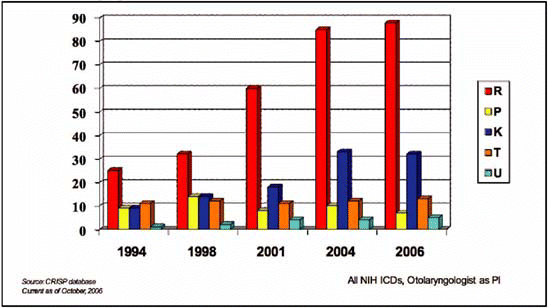Maureen Hannley, PhD, is currently Chief of the Research Division of the Department of Otolaryngology and Communication Sciences at Medical College of Wisconsin and Research Consultant for the Triological Society. She formerly served as the Chief Research Officer of the American Academy of Otolaryngology-Head and Neck Surgery Foundation and has held positions at the National Institutes of Health, Stanford University Medical School, and Arizona State University.
Explore This Issue
September 2007Part 2 of this article will discuss institutional support of research in otolaryngology-head and neck surgery and funding opportunities for researchers.
An important success story has been quietly taking place at the National Institutes of Health over the last decade, which bodes well for patient care, for science, and for the specialty. The number of funded projects with an otolaryngologist as the principal investigator has more than doubled between 1998 (74) and 2007 (152), as shown in Figure 1. The single largest increase has been in the number of research project grants (R mechanisms), followed by career development grants (K mechanisms); other types of funding have remained relatively stable.
Even as the number of R01s (research project grants) awarded to all physicians at NIH declined by 22% between 1998 and 2004, the number of R01s awarded to otolaryngologists in that same time period increased almost threefold. Furthermore, the growth of K grants is significant because it represents growing numbers of young investigators in the pipeline preparing themselves for careers as independent surgeon-scientists. At the institutional level, funding has increased from $36,818,272 to 37 departments in FY 1998 to $98,944,654 to 42 departments in FY 2005 (IMPAC database, www.nih.gov ); these figures include funding to all principal investigators with academic appointments in departments of otolaryngology, not limited to physicians. Funding is actually higher than that represented by these figures, as they reflect only academic departments of otolaryngology, not divisions, and do not include private institutions with active research programs such as Memorial Sloan-Kettering, House Ear Institute, Boys Town National Research Hospital, or Massachusetts Eye and Ear Infirmary; if the list were comprehensive, it would probably exceed $125 million.
Project Focus
The greatest numbers of projects (see Figure 2) are those investigating auditory structures, function, diseases, disorders, or treatments (34.9%). Of these, approximately 65% are using basic (bench) techniques to investigate otitis media, cholesteatoma, tinnitus, syndromic and nonsyndromic hearing impairment, and autoimmune, age-related, and viral-mediated inner ear disorders. The remaining 35% are clinical research projects, including long-term follow-up of cochlear implant patients, optimization strategies for implants, and several clinical trials. Research focused on vestibular or laryngeal functions make up another 18% of the grants.

Leave a Reply